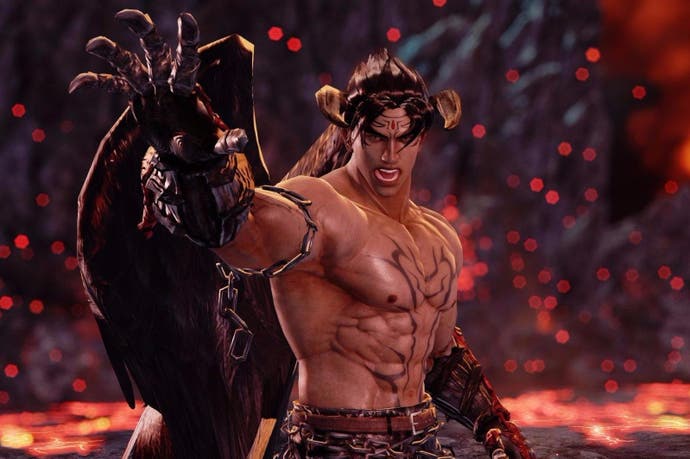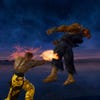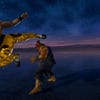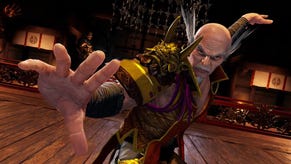Hands-on with Tekken 7 - and its PlayStation VR mode
How Namco's fighter plays in virtual reality, and how Unreal Engine 4 elevates the series.
It's been a long time coming. The arcade version of Tekken 7 first went on test in Japan three years ago, enjoyed a general arcade release in 2015 and was updated with new content a year later. Fast-forward to 2017 and the long-awaited home version is just weeks away from release. An initial hands-on test of the PS4 version suggests that not only has the wait been worth it, but there's an interesting bonus mode too - for the first time ever, a major franchise fighting game is testing the water with a virtual reality mode.
At a recent Namco press event, Digital Foundry had the opportunity to play a near-final iteration of the Tekken 7 code, and yes, we got to experience the gameplay experience within the PlayStation VR visor. Going into the event, we thought that there could be two routes Namco could pursue for Tekken VR support - the gameplay could be uprooted significantly in favour of a first-person viewpoint, or the developers could instead place you as a third-person observer within the VR environment, alongside the two fighters. It's the latter approach that Namco has delivered
There's the sense that the Tekken studio has embraced VR as an experiment first and foremost: in the build we saw, actual gameplay options are limited. There's no HUD, meaning no energy bars, meaning no actual end to any fight. Instead, players practise against a stationary opponent to figure out their combos and learn moves, or else engage a fully-blooded CPU AI in perpetual combat. Character models and Tekken's signature explosive contact effects are in play, but the title's intricate backgrounds are pared back in favour of a moon-lit infinite space.
In short, what we have here is an interesting bonus extra, but assuming this is the entirety of the VR experience we'll get when the game launches in June, it lines up squarely with a range of the kind of 'bolt-on' PSVR modes we've seen attached to a range of top-tier triple-A titles. Namco did tell us that if there is sufficient take-up for the VR mode, more content could follow via DLC updates, but it's safe to say that content is somewhat slim in the version we played. Regardless, the good news is that outside of the VR mode, Tekken 7 certainly looks like the full-blooded current-gen sequel we've been waiting so many years for.
The original arcade version of the game is built from the ground up on PC architecture using Unreal Engine 4 - the same engine deployed for Capcom's Street Fighter 5 - making the transition to home consoles easier than using a bespoke engine. However, Namco has clearly invested a great deal of time and effort into getting the most out of UE4's visual features, while at the same time taking the opportunity to use the technology to further evolve the franchise's signature look. The 3D backgrounds look better than ever, not just in terms of detail level but also in the quality of the lighting and materials. The fighters themselves look beautiful - one step closer to the CG renders we've seen throughout the series' history.
Taking cues from the direction we saw the series moving in Tekken 6, UE4's immense post-process pipeline is deployed to impressive effect, with some interesting choices that may divide opinion in the Tekken fanbase - for example, film grain is utilised heavily, the extent of which seems to vary according to the game mode you're playing (for example, story mode sees a more stylised implementation of the effect). The developers also make excellent use of UE4's suite of effects to really make the most of its signature contact pyrotechnics - here, GPU particles are in play to add an extra layer of impact, an effect emphasised still further in combination with a continuation of the series' impressive dynamic camera work.
Namco's utilisation of Unreal Engine 4 serves a purpose then - to bring a stylised look reminiscent of its prior CG work into real-time, with the team lavishing detail and post-process effects onto a basic gameplay formula that remains highly reminiscent of prior Tekken titles. Yes, you can go into this new sequel safe in the knowledge that a good amount of the characters' moves lists from prior titles have transitioned across, and the familiar animation style is back. Combined with the 'dial a combo' move input system and the rock-solid 60fps performance level, there's no doubt that despite the engine change and its associated visual upgrades, this is a thoroughbred Tekken game, and one that series purists should warm to immediately.
If there is a compromise dealt to the game by the implementation of Unreal Engine 4, it seems to come in the form of a reduced resolution. UE4 typically employs a form of temporal anti-aliasing that can make pixel-counting difficult, but the soft nature of the presentation doesn't seem to derive just from the extensive post-processing effects, but also from a native resolution that seems to resolve closer to 900p than the standard 1080p we tend to see on PlayStation 4 titles. Anti-aliasing coverage is also spotty at points, leading to visible jaggies across clean edges on some of the more industrial stages, which occasionally takes away some of the refinement from the presentation.
Bearing in mind how lush the title looks overall, it's not exactly a big issue (and we've yet to see the PS4 Pro enhancements) but it is worth remembering that Tekken 7 is a multi-platform release: given the appropriate level of hardware, the PC version should be able to power through to 1080p and beyond, but we do wonder what Namco's strategy will be for Xbox One.
Overall, we came away from our Tekken 7 hands-on excited about the game's prospects. It feels familiar enough that old hands will be able to dive in straight away, but there seem to be enough additions to the formula to ensure that veteran players still have much to learn and discover. Meanwhile, the gameplay remains accessible enough for newcomers to enjoy, and the Unreal Engine 4-powered visuals do look seriously impressive. The outlook for PC, PS4 Pro and Xbox One is the key unknown though, and we'll report back on that as soon as we can.















